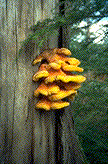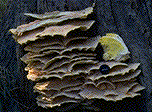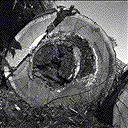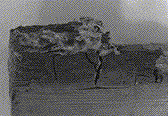Archived Content
Information identified as archived on the Web is for reference, research or recordkeeping purposes. It has not been altered or updated after the date of archiving. Web pages that are archived on the Web are not subject to the Government of Canada Web Standards. As per the Communications Policy of the Government of Canada, you can request alternate formats on the Contact Us page.
Brown Cubical Rot
Laetiporus sulphureus (Bull.:Fr.) Murrill
(= Polyporus sulphureus (Bull.:Fr.) Fr.)
Basidiomycotina, Aphyllophorales, Polyporaceae
Hosts: Laetiporus sulphureus affects a wide range of coniferous and deciduous hosts. In B.C. it has been reported on western hemlock, Engelmann, white and Sitka spruce,Garry oak, true firs, larch, spruce, ponderosa and western white pine, Douglas-fir, and western redcedar. In other parts of North America it has also been found on lodgepole pine, subalpine and amabilis fir, maple, birch, chestnut, ash, walnut, poplar, Prunus spp., pear, willow, sequoia, and elm. In the east it is restricted to deciduous hosts, most commonly oak.
Distribution: This fungus is widely distributed throughout the range of its hosts in B.C.
Identification: The fruiting bodies are annual, spongy to leathery, bracket-like or occasionally stalked, up to 40 cm wide (Figs. 15a, 15b). They often occur in large clusters up to a square metre or more in extent. The upper surface is bright orange-yellow, the context is white to yellow and the lower surface is sulphur yellow with regular pores. Old specimens become brittle when dry and white throughout with a strong, pungent odour. Fruiting bodies seldom form on living coniferous trees but may develop on living deciduous hosts.
The incipient state of the decay appears as a light brown stain. Later the wood breaks into small, red-brown cubes, sometimes having a rippled appearance (Fig. 15c). White, relatively thick mycelial felts may form in the shrinkage cracks within the decay (Fig. 15d).
Microscopic Characteristics: Hyphae in the context of the fruiting body thin-walled, hyaline, simple septate. Basidiospores ovoid to ellipsoid, hyaline, smooth, IKI-, 5-8 x 4-5 µm. Growth in culture moderately rapid, mat white to buff or salmon, laccase negative, clamps always absent. Stalpers: (7) (8) (9) 11 13 14 18 19 (21) 31 (32) (33) 35 48 50 (52) 53 54 55 (80) (82) 83 (84) 85 86 (87) (89) (90).
Damage: Fruiting bodies are often not formed until years after the fungus is well established, so when present, they indicate significant internal defect. The rot is generally restricted to the butt log. When present in recreation sites, infected trees should be considered hazardous and should be removed.
Remarks: The decay caused by L. sulphureus is similar to that of Fomitopsis officinalis, but the mycelial felts are not bitter. Laetiporus sulphureus is a commonly harvested as an edible fungus, easily identified by the morphology and bright yellow colour of its fruiting bodies.
References:
Gilbertson, R. L. and L. Ryvarden. 1986. North American Polypores. 1:424. Fungiflora, Oslo.
Figures
Click on any image to see the full size version.
Press "Back" on your browser to return to this screen.

Figure 15a: Fruiting bodies of L. sulphureus.
 Figure 15b: Fruiting bodies of L. sulphureus.
Figure 15b: Fruiting bodies of L. sulphureus.
 Figure 15c: Brown cubical rot symptom caused by L. sulphureus.
Figure 15c: Brown cubical rot symptom caused by L. sulphureus.
 Figure 15d: White mycelial felts associated with decay.
Figure 15d: White mycelial felts associated with decay.
 This Web page has been archived on the Web.
This Web page has been archived on the Web.